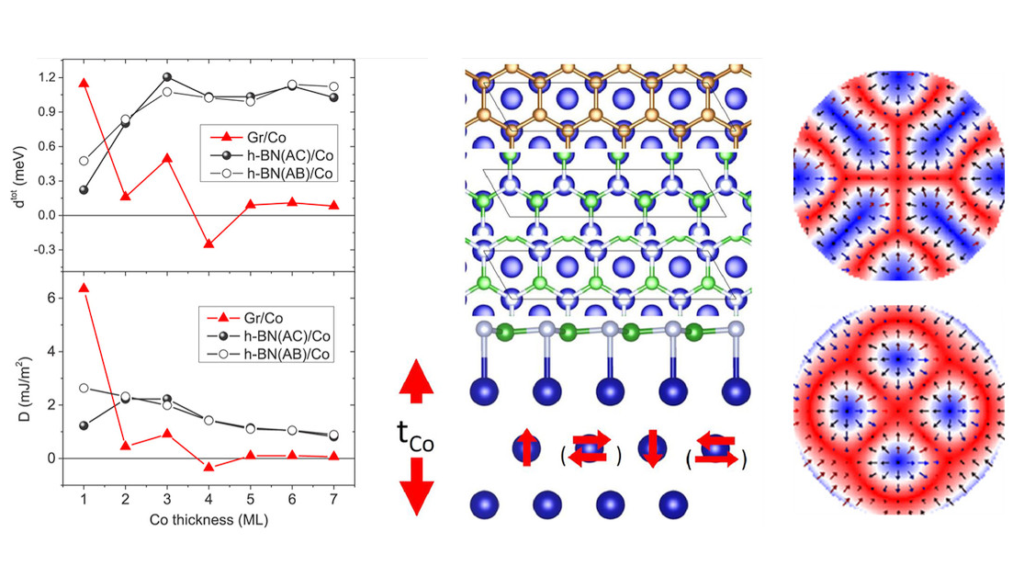Significant Dzyaloshinskii–Moriya interaction (DMI) and perpendicular magnetic anisotropy (PMA) at interfaces comprising hexagonal boron nitride (h-BN) and cobalt (Co) remaining stable over a large range of Co film thickness are reported. Furthermore, it is demonstrated that that such significant DMI and PMA give rise to the formation of skyrmions with small applied external fields.
Interfacial Dzyaloshinskii–Moriya interaction (DMI) and perpendicular magnetic anisotropy (PMA) in magnetic nanostructures traditionally composed of metals and/or oxides have gained much attention in recent years since they play a major role in the formation of chiral magnetic structures, such as spin spirals and skyrmions, which are promising for the next generation of data storage devices. On another hand, two-dimensional (2D) materials such as graphene (Gr) and hexagonal boron nitride (h-BN) are appealing as novel materials with exceptional properties that can replace conventional ones and open new prospects for information technology.
In this work, significant and robust DMI and PMA at 2D material/Co interfaces is demonstrated using first-principles calculations. By comparing the behavior of these phenomena at graphene/Co and h-BN/Co interfaces of different stacking, even though the PMA behavior shows similarities for both cases, the DMI at h-BN/Co interface shows significantly larger values remaining robust over a large Co thickness range unlike for Co/Gr interface [Figure below]. The physical mechanisms of such behavior are attributed to existence of competing dipoles at the Co/Gr interface compared to only one dipole at the opposite h-BN/Co interface which gives rise to a larger DMI associated with stronger Rashba spin-orbit coupling in case of h-BN/Co compared to that of Co/Gr. Furthermore, the possibility of skyrmions formation at h-BN(AC)/Co interface with the application of small external magnetic field and stable up to hundred Kelvin is demonstrated.
Microscopic and micromagnetic DMI coefficients as a function of Co thickness (left panel) of Gr/Co, h-BN(AB)/Co and h-BN(AC)/Co structures shown in the middle panel, respectively. Right panel shows relaxed magnetization distributions of 100 nm wide h-BN(AC)/Co(3ML) with labyrinth domains transformed into skyrmion states at finite external magnetic field applied
Compared to the widely studied skyrmion materials based on ferromagnet/heavy-metal interfaces, h-BN/Co and Gr/Co systems are simpler to synthesize and free of heavy metals being advantageous to lower Gilbert damping beneficial for the realization of low critical driving current density and high-speed skyrmion motion. Furthermore, the realization of skyrmions in h-BN/Co represents interesting perspective toward exploring interfaces comprising other 2D materials. These findings can not only demonstrate that 2D materials such as h-BN provide a viable alternative for heavy metals in the next-generation spintronic devices based on domain wall or skyrmions, but also inspire further investigations on the exotic magnetic properties on the 2D material/magnetic metal interfaces.
Team: Theory and Simulation
Collaboration: UMPhy CNRS/Thalès (France), NIMTE (China)
Funding: EU Horizon 2020 (Graphene Flagship), NSFC & CAS (China)
Further reading: Rashba-Type Dzyaloshinskii–Moriya Interaction, Perpendicular Magnetic Anisotropy, and Skyrmion States at 2D Materials/Co Interfaces, A. Hallal, J. Liang, F. Ibrahim, H. X. Yang, A. Fert and M. Chshiev, Nano Lett. 21, 7138 (2021).
Contact: Mairbek Chshiev

